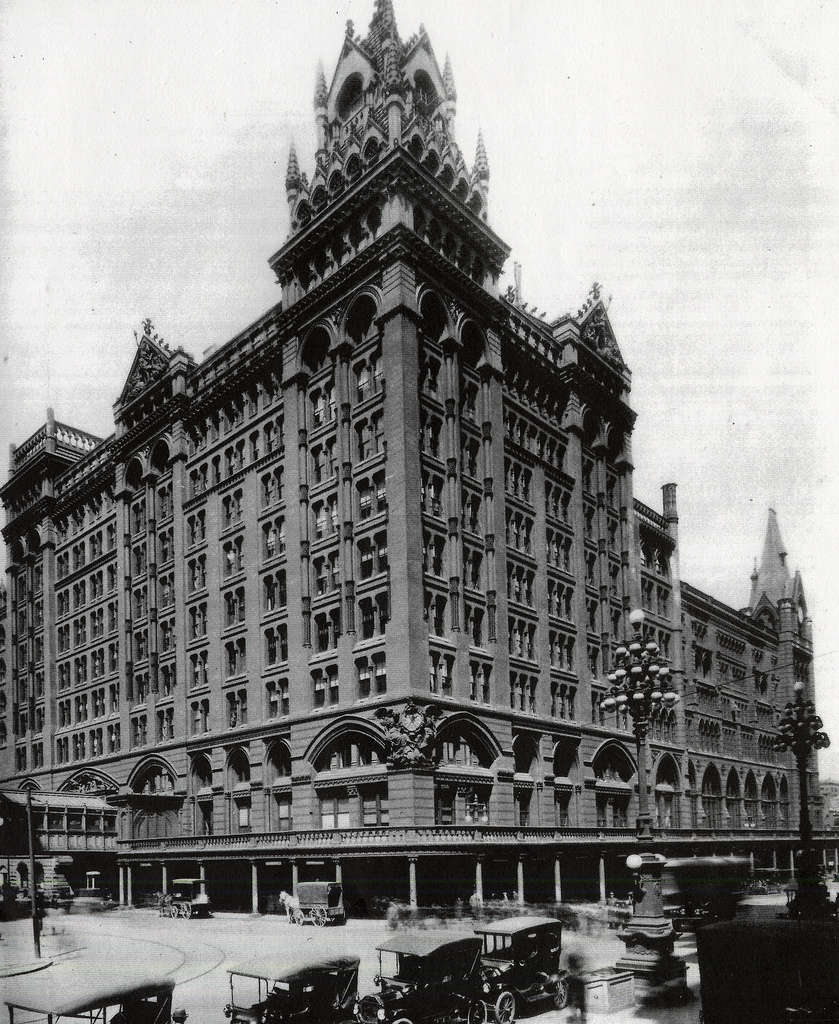
FLICKR: Broad Street Station (demolished) at Broad & Market Streets was the primary passenger terminal for the Pennsylvania Railroad (PRR) in Philadelphia, Pennsylvania from 1881 to the 1950s. Directly west of City Hall, the office towers of Penn Center now occupy the site. Originally designed by Wilson Brothers & Company in 1881, Broad Street Station was dramatically expanded by renowned Philadelphia architect Frank Furness, 1892-93. In 1894, the PRR relocated its headquarters from Fourth Street to the office building above the station, where they remained until moving to the Suburban Station Building in the 1930s. It was finally demolished in 1953, a year after all train service to it had ceased. Broad Street Station dominated the center of the city. Trains would enter and exit the station two stories above street level on a viaduct known as the “Chinese Wall” and run west to cross the Schuylkill River. The access tracks thus bisected the western half of Center City Philadelphia into north and south. Fifteenth Street ran beneath the station’s lobby, and all the numbered streets up to 24th ran beneath the viaduct. John F. Kennedy Boulevard traces a similar path today. MORE
RELATED: Noted historian and architect Robert M. Skaler will present a lecture and a series of images illustrating the development of North Broad Street in the 19th century. While prosperous, North Broad Street was respectable but never really fashionable, as a “north” address did not have the cache of one south of Market Street to Philadelphia’s traditional elite class ensconced around Rittenhouse Square. Perhaps to compensate for this lack of social standing, residents of North Broad Street built their houses and churches grander than many in Center City preferring the clean “Uptown” air to that of the old Quaker City with its cramped hurley-burley. In addition, it is the home of Temple University and the Wagner Free Institute of Science. North Broad Street was also the center of social life of upper class German Jews who built four major synagogues, and the impressive Mercantile Club on Broad below Jefferson Street. Robert M. Skaler is a forensic architect and graduate of the University of Pennsylvania School of Architecture. He is a Past President of the Philadelphia Chapter of the Victorian Society, board member of the Old York Road Historical Society member of the Union League of Philadelphia, and is an adviser to several Historic Societies. His books entitled West Philadelphia, University City to 52nd Street, Philadelphia’s Broad Street, South & North, and Society Hill & Old City, and Philadelphia’s Rittenhouse Square with co-author Tom Keels, are pictorial histories of Philadelphia. Following his lecture Mr. Skaler will sign copies of his book.
A History of North Broad Street: A Lecture by Robert Morris Skaler
Wednesday, March 31, 5 pm
Wagner Free Institute of Science
1700 West Montgomery Avenue
Philadelphia, PA 19121
Free and open to the public
